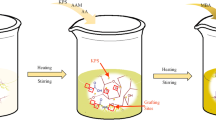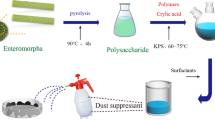Abstract
To solve issues of low consolidation strength, poor dust suppression effect, and secondary pollution of the current coal dust suppressors, a greener and higher-consolidation-strength composite dust suppressor was synthesized by the radical polymerization of xanthan gum (XG) as the graft substrate, methyl acrylate (MA), and vinyl acetate (VAc) as the graft monomers. Taking compressive strength as the main optimization index and viscosity and surface tension as the secondary indices, the optimum ratio of MA:VAc was 3:5 and the optimum solid content was 2%. Experiments reveal that the prepared dust suppressant can naturally infiltrate into coal to form a hard solidified layer. At a wind speed of 10 m/s, the solidified layer still maintained structural integrity, indicating that the dust suppressant exhibits a good dust fixation effect. The dust suppressant can not only maintain relatively stable performance for a period of time but also degrade naturally. Furthermore, molecular dynamics simulation reveals not only the interaction mechanism between coal molecules and the dust suppressor but also the wetting mechanism of the dust suppressor. Experimental and simulation results reveal that as a multifunctional dust suppressor with excellent performance, the as-prepared dust suppressor demonstrates the immense potential for the control of coal dust.

Graphical abstract














Similar content being viewed by others
Data Availability
All data generated or analyzed during this study are included in this published article.
References
Bao Q, Nie W, Liu CQ, Liu YH, Zhang HH, Wang HK, Jin H (2019) Preparation and characterization of a binary-graft-based, water-absorbing dust suppressant for coal transportation. J Appl Polym Sci 136:47065. https://doi.org/10.1002/app.47065
Chen DW, Nie W, Cai P, Liu ZQ (2018) The diffusion of dust in a fully-mechanized mining face with a mining height of 7 m and the application of wet dust-collecting nets. J Clean Prod 205:463–476. https://doi.org/10.1016/j.jclepro.2018.09.009
Chen J, Pan X, Li HQ, Jin HH, Fan JR (2020) Molecular dynamics investigation on the gasification of a coal particle in supercritical water. Int J Hydrogen Energy 45:4254–4267. https://doi.org/10.1016/j.ijhydene.2019.12.002
Cybulski K, Malich B, Wieczorek A (2015) Evaluation of the effectiveness of coal and mine dust wetting. J Sustain Min 14:83–92. https://doi.org/10.1016/j.jsm.2015.08.012
Dixon-Hardy DW, Beyhan S, Ediz IG, Erarslan K (2008) The use of oil refinery wastes as a dust suppression surfactant for use in mining. Environ Eng Sci 25:1189–1195. https://doi.org/10.1089/ees.2007.0177
Domazetis G, James BD (2006) Molecular models of brown coal containing inorganic species. Org Geochem 37:244–259. https://doi.org/10.1016/j.orggeochem.2005.07.006
Dzionek A, Wojcieszynska D, Adamczyk-Habrajska M (2021) Xanthan gum as a carrier for bacterial cell entrapment: developing a novel immobilised biocatalyst. Mat Sci Eng C-Mater 118:111474. https://doi.org/10.1016/j.msec.2020.111474
Han WB, Zhou G, Zhang QT, Pan HW, Liu D (2020) Experimental study on modification of physicochemical characteristics of acidified coal by surfactants and ionic liquids. Fuel 266:116966. https://doi.org/10.1016/j.fuel.2019.116966
Han C, Zhang YP, Redmile-Gordon M, Deng H, Gu ZG, Zhao QG, Wang F (2021) Organic and inorganic model soil fractions instigate the formation of distinct microbial biofilms for enhanced biodegradation of benzo[a]pyrene. J Hazard Mater 404:124071. https://doi.org/10.1016/j.jhazmat.2020.124071
Hong S, Liu ZT, Zhao EL, Lin S, Qiu LM, Qian JF, Liu HX, Xia SK (2017) Comparison of behavior and microscopic characteristics of first and secondary explosions of coal dust. J Loss Prevent Proc 49:382–394. https://doi.org/10.1016/j.jlp.2017.08.005
Hu SY, Liao Q, Feng GR, Huang YS, Shao H, Gao Y, Hu F (2020) Influences of ventilation velocity on dust dispersion in coal roadways. Powder Technol 360:683–694. https://doi.org/10.1016/j.powtec.2019.09.080
Huang ZA, Huang Y, Yang ZJ, Zhang J, Gao YK, Shao ZL, Zhang YH, Chen ML (2021a) Numerical simulation of the dust production and transportation law of an intermediate mine heap. ACS Omega 6:1623–1635. https://doi.org/10.1021/acsomega.0c05598
Huang T, Tu ZC, Shangguan XC, Wang H, Zhang L, Bansal N (2021b) Characteristics of fish gelatin-anionic polysaccharide complexes and their applications in yoghurt: rheology and tribology. Food Chem 343:128413. https://doi.org/10.1016/J.FOODCHEM.2020.128413
Huang ZA, Zhao W, Yang ZJ, Zhang J, Gao YK, Shao ZL, Zhang YH, Zhang LH, Wen SY (2021c) Preparation and characterization of an environmentally friendly compound chemical agent for road dust suppression in a copper mine. ENVIRON PROG SUSTAIN 40:e13532. https://doi.org/10.1002/EP.13532
Jiang BY, Sun Q, Ni GH (2020) Study on the wettability of a composite solution based on surface structures of coal. ACS Omega 5:28341–28350. https://doi.org/10.1021/acsomega.0c04345
Jin Y, Fan JG, Pang J, Wen K, Zhang PY, Wang HQ, Li T (2018) Risk of Active pulmonary tuberculosis among patients with coal workers’ pneumoconiosis: a case-control study in China. Biomed Environ Sci 31:448–453. https://doi.org/10.3967/bes2018.058
Kollipara VK, Chugh YP, Mondal K (2014) Physical, mineralogical and wetting characteristics of dusts from interior basin coal mines. Int J Coal Geol 127:75–87. https://doi.org/10.1016/j.coal.2014.02.008
Li KC, Yang L, Jiang FQ, Tang Y (2012) Preparation and research on coal dust suppressant from modified lignosulfonates. Huanjing Gongcheng 30:66–69. https://doi.org/10.13205/j.hjgc.2012.01.024
Liu ZQ, Zhou G, Li SL, Wang CM, Liu RL, Jiang WJ (2020) Molecular dynamics simulation and experimental characterization of anionic surfactant: influence on wettability of low-rank coal. Fule 279:118323. https://doi.org/10.1016/j.fuel.2020.118323
Lnyang HL, Bae SY, Pando MA (2016) Contaminant dust suppression materials: a cost-effectiveness estimation methodology. Measurement 93:563–571. https://doi.org/10.1016/j.measurement.2016.07.024
Ma D, Qin BT, Gao Y, Jiang JN, Feng BC (2020) Study on the explosion characteristics of methane–air with coal dust originating from low-temperature oxidation of coal. Fuel 260:116304. https://doi.org/10.1016/j.fuel.2019.116304
Makhado E, Pandey S, Ramontja J (2018) Microwave assisted synthesis of xanthan gum-cl-poly (acrylic acid) based-reduced graphene oxide hydrogel composite for adsorption of methylene blue and methyl violet from aqueous solution. Int J Biol Macromol 119:255–269. https://doi.org/10.1016/j.ijbiomac.2018.07.104
Medeiros MA, Leite CMM, Lago RM (2012) Use of glycerol by-product of biodiesel to produce an efficient dust suppressant. Chem Eng J 180:364–369. https://doi.org/10.1016/j.cej.2011.11.056
Ni GH, Sun Q, Meng X, Wang H, Cheng WM, Wang G (2019) Effect of NaCl-SDS compound solution on the wettability and functional groups of coal. Fuel 257:116077. https://doi.org/10.1016/j.fuel.2019.116077
Pandey S, Ramontja J (2016) Rapid, facile microwave-assisted synthesis of xanthan gum grafted polyaniline for chemical sensor. Int J Biol Macromol 89:89–98. https://doi.org/10.1016/j.ijbiomac.2016.04.055
Quan HP, Hu YL, Huang ZY, Duan WM (2020) Preparation and property evaluation of a hydrophobically modified xanthan gum XG-C16. J Disper Sci Technol 41:656–666. https://doi.org/10.1080/01932691.2019.1610425
Shen FH, Liu HB, Yuan JX, Han B, Cui K, Ding Y, Fan XY, Cao H, Yao SQ, Suo X (2015) Cost-effectiveness of coal workers’ pneumoconiosis prevention based on its predicted incidence within the Datong Coal Mine Group in China. PLoS One 10:e0130958. https://doi.org/10.1371/journal.pone.0130958
Siggins A, Thorn C, Healy MG, Abram F (2021) Simultaneous adsorption and biodegradation of trichloroethylene occurs in a biochar packed column treating contaminated landfill leachate. J Hazard Mater 403:123676. https://doi.org/10.1016/J.JHAZMAT.2020.123676
Wang LS, Chen ZW, Wang CG, Elsworth D, Liu WT (2019) Reassessment of coal permeability evolution using steady-state flow methods: the role of flow regime transition. Int J Coal Geol 211:103210. https://doi.org/10.1016/j.coal.2019.103210
Wang PF, Han H, Tian C, Liu RH, Jiang YD (2020) Experimental study on dust reduction via spraying using surfactant solution. Atmos Pollut Res 11:32–42. https://doi.org/10.1016/j.apr.2020.02.010
Wu MY, Hu XY, Zhang Q, Lu W, Zhao YY, He ZL (2020) Study on preparation and properties of environmentally-friendly dust suppressant with semi-interpenetrating network structure. J Clean Prod 259:120870. https://doi.org/10.1016/j.jclepro.2020.120870
Xi ZL, Feng ZY, Li A (2017) Synergistic coal dust control using aqueous solutions of thermoplastic powder and anionic surfactant. Colloid Surface A 520:864–871. https://doi.org/10.1016/j.colsurfa.2017.02.072
Xu Z, Song K, Yuan SL, Liu CB (2011) Microscopic wetting of self-assembled monolayers with different surfaces: a combined molecular dynamics and quantum mechanics study. Langmuir 27:8611–8620. https://doi.org/10.1021/la201328y
Yang J, Wang F, Fang L, Tan TW (2007) Synthesis, characterization and application of a novel chemical sand-fixing agent-poly (aspartic acid) and its composites. Environ Pollut 149:125–130. https://doi.org/10.1016/j.envpol.2006.12.021
Yang J, Wu XK, Gao JG, Li GP (2010) Surface characteristics and wetting mechanism of respirable coal dust. Int J Min Sci Technol (China) 20:365–371. https://doi.org/10.1016/S1674-5264(09)60209-X
Zhang R, Xing YW, Xia YC, Luo JQ, Tan JL, Rong GQ, Gui XH (2020) New insight into surface wetting of coal with varying coalification degree: an experimental and molecular dynamics simulation study. Appl Surf Sci 511:145610. https://doi.org/10.1016/j.apsusc.2020.145610
Zhang LW, Zhang YM, Huang XJ, Tao LM, Bi YP (2021) Direct observation of dynamic interfacial bonding and charge transfer in metal-free photocatalysts for efficient hydrogen evolution. Appl Catal B-Environ 283:119633. https://doi.org/10.1016/J.APCATB.2020.119633
Zhou G, Ma YL, Fan T, Wang G (2018) Preparation and characteristics of a multifunctional dust suppressant with agglomeration and wettability performance used in coal mine. Chem Eng Res Des 132:729–742. https://doi.org/10.1016/j.cherd.2018.02.021
Zhou G, Ding JF, Ma YL, Li SL, Zhang MG (2020a) Synthesis and performance characterization of a novel wetting cementing agent for dust control during conveyor transport in coal mines. Powder Technol 360:165–176. https://doi.org/10.1016/j.powtec.2019.10.003
Zhou WD, Wang HT, Wang DM, Du YH, Zhang K, Qiao YC (2020b) An experimental investigation on the influence of coal brittleness on dust generation. Powder Technol 364:457–466. https://doi.org/10.1016/j.powtec.2020.01.074
Zhou Q, Xu G, Chen YP, Qin BT, Zhao ZD, Guo CW (2020c) The development of an optimized evaluation system for improving coal dust suppression efficiency using aqueous solution sprays. Colloid Surface A 602:125104. https://doi.org/10.1016/j.colsurfa.2020.125104
Acknowledgements
Author gratitude is extended to the prospective editor(s) and reviewers that will/have spared time to guide toward a successful publication.
Funding
This work was supported by the National Key Technologies R&D Program of China (2018YFC0807900); the Taishan Scholars Project Special Funding in Shandong Province, China (TS20190935); the Key Program of the National Natural Science Foundation of China (42077444, 51674038, 51874193); the Shandong Province Natural Science Foundation (ZR2020ME101 and ZR2018JL019); the Shandong Province Science and Technology Development Plan (2017GSF220003); the Qingchuang Science and Technology Program of Shandong Province University (2019KJG008); the Shandong Province First Class Subject Funding Project (01AQ05202); and the Taishan Scholar Talent Team Support Plan for Advantaged & Unique Discipline Areas.
Author information
Authors and Affiliations
Contributions
Miao-Miao Li, Jian Qiao, and Yan-Yun Zhao conceived the work and designed the experiments and synthesized the novel dust suppressant; Su-Su Bian, Shi-Jian Yu, and Xiang-Ming Hu analyzed the microstructure, viscosity, and surface tension of the dust suppressant; Miao-Miao Li, Su-Su Bian, and Jian Qiao tested and analyzed the wind erosion resistance, biodegradability, water retention, and compressive strength of the dust suppressant; Miao-Miao Li and Su-Su Bian used molecular dynamics to simulate the mechanism of dust suppressant; Xiang-Ming Hu performed FTIR and NMR; Miao-Miao Li, Yan-Yun Zhao, and Shi-Jian Yu wrote the manuscript with contributions from all authors.
Corresponding authors
Ethics declarations
Ethics approval and consent to participate
Not applicable
Consent for publication
The authors have given consent for submission and subsequent publication of the manuscript.
Competing interests
The authors declare no competing interests.
Additional information
Responsible Editor: Santiago V. Luis
Publisher’s note
Springer Nature remains neutral with regard to jurisdictional claims in published maps and institutional affiliations.
Rights and permissions
About this article
Cite this article
Li, ., Zhao, Y., Bian, S. et al. A green, environment-friendly, high-consolidation-strength composite dust suppressant derived from xanthan gum. Environ Sci Pollut Res 29, 7489–7502 (2022). https://doi.org/10.1007/s11356-021-16258-3
Received:
Accepted:
Published:
Issue Date:
DOI: https://doi.org/10.1007/s11356-021-16258-3




